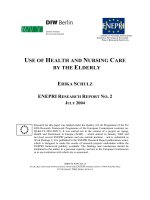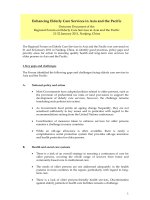Working in Health and Social Care pptx
Bạn đang xem bản rút gọn của tài liệu. Xem và tải ngay bản đầy đủ của tài liệu tại đây (21.82 MB, 216 trang )
ELSEVIER
CHURCHILL
LIVINGSTONE
©
200<>,
Elsevier I imited. All rights reserved.
The right
of
Teena J
Clouston
and
Lyn Westcott to be identified as
authors
of
this
work
has been asserted oy
them
in
accordance
with
the
Copyright, Designs
and
Patents
Act 1988.
No
pan
of
this
publication
may
be
reproduced,
stored
in a retrieval system,
or
transmitted
in an) form or by any
means,
electronic,
mechanical,
photocopying,
recording or otherwise,
without
either
the
prior
permission
of
the
publishers
or
a licence
permitting
restricted
copying
in the
United
Kingdom
issued by the
Copyright
Licensing
Agency,
90lottenham
Coun
Road,
London
WIT
41.1'.
Permissions
may
be
sought
directly from Elsevier's
Health
Sciences Rights
Department
in
Philadelphia,
liSA:
phone:
(+
1) 215 238
7869,
fax:
(+
1) 215 238
2239,
e-mail:
healthpermissionseselsevier.corn.
You may also
complete
your
request
on-line
via
the
Elsevier
hornepage
(). by selecting
'Customer
Support'
and
then
'Obtaining
Permissions'.
lirst
published
2005
ISBN 044.3
074887
British
Library
Cataloguing
in
Publication
Data
A catalogue record for this
book
is available
from
the
British Library
Library
of
Congress
Cataloging
in
Publication
Data
A catalog record for this
book
is available from
the
Library
of
Congress
Notice
Knowledge
and
best practice in
this
field are
constantly
changing.
As new research
and
experience
broaden
our
knowledge,
changes
in practice,
treatment
and
drug
therapy
may
become
necessary
or
appropriate.
Readers are advised to check
the
most
cu rrent
information
provided
(i) on
procedures
featured
or
(ii) by
the
manufacturer
of
each
product
to be
administered,
to verify
the
recommended
dose
or
formula,
the
method
and
duration
of
administration,
and
contra
indications. It is
the
responsibility
of
the
practitioner, relying on
their
own
experience
and
knowledge
of
the
patient,
to
make
diagnoses, to
determine
dosages
and
the
best
treatment
for each
individual
patient,
.1I1d
to take all
appropriate
safety
precautions.
To
the
fullest extent
of
the law,
neither
the
Publisher
nor
the
editors
assume
any
liability for any
injury
and/or
damage.
The Publisher
Working together
to
grow
libraries in developing countries
www.elsevier.com I www.bookaid.org I www.sabre.org
_
yc,ur source for books,
• journolsand multimedia
in
the
health
sciences
www.elsevierhealth.com
Printed in
the
1IK
The
Publisher's
poliCy
IS10use
paper
manufocrured
from
sustainable
forests
I
Dedication
For
our
friend
Claire:
'May
your
soul
and
spirit
fly:
Contributors
Martin
Booy MA
HA
DipCOTTDipCOT
IU'M
Dean
of
Healthcare Studies
and
Director
of
Occupational
Therapy
Education, Wales College
of
Medicine, Biology, Life
and
Health Sciences,
Cardiff
University,
Cardiff
Teena Clouston MHA PCDip(Rese.lrch)
DipCOT
DipColins
IlTM
Senior
Lecturer, Wales College
of
Medicine, Biology, Life
and
I
lealth
Sciences,
Cardiff
University,
Cardiff
Deb
Hearle
MSc
DipCOTCertEd(IIE)
DIPISM IlTM
Deputy
Director,
Occupational
Therapy, Wales College
of
Medicine, Biology,
Life
and
Health Sciences, Cardiff University,
Cardiff
Helen
Hortop
DipCOT
DBA
Honorary
Fellow,
Cardiff
University, Head
of
Occupational
Therapy Services,
Cardiff
and
Vale Trust,
Cardiff
Ritchard Ledgerd HScOT
(lions)
International
Manager, Reed Health Group,
London
Linda Lovelock HA(lIons)
PhD
DipCOT
Senior
Lecturer, School
of
Health Professions, University
of
Brighton
Tracey Poiglase MSc
DipCOT
PCCE(IIE)
PCDip
IlTM
Deputy
Programme
Manager, Wales College
of
Medicine, Biology, Life
and
Health Sciences,
Cardiff
University,
Cardiff
Gwilym
Wyn
Roberts MA
DipCOT
PCDip(
Psych) FlCP
Deputy Director
of
Occupational
Therapy, Wales College
of
Medicine, Biology,
Life
and
Ilealth
Sciences,
Cardiff
University,
Cardiff
Robin Sasaru
Clinical Audit Manager, Walsall Teaching Primary Care Trust, Walsall
Soma
Sasaru
Clinical Audit Assistant, Walsall Teaching Primary Care Trust, Walsall
Yvette
Sheward
Director
of
Clinical Governance
and
Training, Walsall Teaching Primary Care
Trust, Walsall
Elizabeth Stallard
BA(lIons)l.aw
Senior
Solicitor at Welsh Health Legal Services
viii
Contributors
Lyn
Westcott
MSc BSc
DipCOT
RegC)T
Senior Lecturer
and
Programme Manager, Wales College
of
Medicine, Biology,
Life
and
Health Sciences, Cardiff University, Cardiff
Steven W.
Whitcombe
MSc BA(lIol1s) 8Sc(1I0I1s)OT PGCE(PCEJ')
fUM
Lecturer in
Occupational
Therapy, Wales College
of
Medicine, Biology, Life
and
Health Sciences, Cardiff University, Cardiff
Paul K.Wilby MEd
BEd(SpEd)
MCSP
DipTP
CertEd(FE)
Director
of
Interprofessional Education, Wales College
of
Medicine, Biology,
Life
and
Health Sciences, Cardiff University, Cardiff
Foreword
All allied health professionals who work within health and social care in the UK
should
be advised to reflect on the words
of
Johann Wolfgang von Goethe, the
18th century German dramatist,
who
wisely wrote
'What
we do
not
understand
we do
not
possess.'
The health and social care organisations within the UK are amongst the
biggest employers in the world. To practise within them, therefore, is
both
a
unique
and
common
experience. Because
of
their size, their relationship to
central
and
local government
and
their place in the national consciousness,
health
and
social care in the UK have developed their
own
cultures, systems
and
philosophies, and these impact in a very real way on the day-to-day
practice
of
the people
who
work in them.
To practise effectively in any situation it is vital to have
not
only knowledge,
but
also an understanding
of
the context in which that practice takes place. To
practise in ignorance of
the
pressures, powers and drivers
of
the organisation in
which you work is to deny
both
yourself
and
those
who
access your service, full
use of your knowledge
and
skills. If we concentrate only on the issues
of
the
people we serve then as practitioners we will be at the
whim
and behest
of
the
organisation which employs us. Tounderstand
both
the macro
and
micro drives
and
cultures within health and social care, to understand its politics, policies,
changes
and
philosophy, is
not
only essential for effective practice
but
also
enables us to have some control
and
influence over that section
of
the
system in which we practise. Therapists
who
can positively use
and
influence
the context in which they practise are those who will best serve the public for
whom
they work.
To be an effective practitionerwithin health
and
social care requires a knowl-
edge
and
understanding
of
how
the system sees, and what it requires
of
its practitioners. The culture that exists within
both
the organisation
and
the
country has high expectations
of
its practitioners. Its expectations of autono-
mous, ethical, effective, evidence-based, professional practice stem from its
understanding
of
professional working. To be effective, therefore, requires prac-
titioners to have a level
of
understanding and
commitment
to these prin-
ciples in order to develop
and
deliver a service that will best serve the public
who own it.
Choosing to enter health and social care within the UK requires not only a
commitment
to becoming a public servant
but
also an understanding
of
how to
develop a career pathway that best serves
the
talents and aspirations
of
the indi-
vidual. Practitioners
who
successfully develop their career are those
who
will
continuously develop
and
use their talents to
the
full. Career development
within a large organisation offers many
and
varied opportunities. However it
also requires individual professionals to have a knowledge and understanding
of
the organisation in order to ensure their best pathway through it.
A text such as this, therefore, that helps allied health professionals to
understand the context
of
health
and
social care in the UK and their unique
x
Foreword
position within it, will be an invaluable source of reference. To be able to access
a text that helps build a clear
and
dynamic view of
the
culture
and
systems in
which they are working is
one
that will help each practitioner towards more
effective
and
efficient practice. As Francis Bacon famously wrote in 1597
'Knowledge itselfis power.' To best serve the public from within a large organi-
sation practitioners need to have a clear understanding of their place within it,
and
this timely text will certainly help the process of making sense of
and
there-
fore practising most effectively within the ever-changing health
and
social care
organisations.
Annie
Turner
TDipCOT
MA FCOT
Head of Division of Occupational Therapy
Centre for Health Care and Education
University College,
Northampton
Foreword
The title
of
this
book
explains very accurately what it contains, and the
content must be
of
interest to a whole range
of
professional groups. It will be
particularly relevant to newly qualified practitioners
and
final year students who
have, or are preparing to, embark
on
their career in
one
of the allied health pro-
fessions. Unfortunately
the
term allied health professions (AHPs) can hide the
fact that there are some strong professional 'tribes' and it is my
hope
that this
book
is seen as truly multi-professional as the content is relevant to many, and
the profession
of
the
authors is of little relevance.
Teena Clouston and Lyn Westcott have assembled a range
of
experts
who
have all made a significant contribution to this text. As editors, Lyn and
Teena have managed to keep control
of
academics
and
practitioners - which has
been likened to herding cats - by introducing
and
summarising each
of
the four
sections
of
the
book
themselves. From my own experience of editing multi-
author
books, establishing consistency
of
style without taking away the
unique
nature
of
the
individual contributions is important. I think the editors have
achieved this very difficult task
and
the
end
result is commendable.
The
book
is made up
of
four sections. Part 1 - Setting the Scenefor
Practice
is made up
of
three chapters covering contexts, systems
and
change. Part 2 -
Development of the
Professions
and Individual
Practitioner
has four chapters
and
covers sociological perspectives, tearnworking, continuous professional
development and development
of
the allied health professions. Part 3 -
Professional
Influences
on
Practice
has four chapters covering quality, evidence-
based practice, audit
and
legal influences. Part 4 -
First
Steps
into
Practice
has two
chapters
and
appropriately covers preparing and developing your work and
securing a post for employment.
From these section headings it can be seen that the authors have managed to
cover most areas
that
surround practice. I think this is
the
real strength
of
the
book
as it appreciates the context within which the reader will operate,
but
does
not
get
hung
up on the intricacies of individual professions. This is
not
an occupational therapy
book
written for occupational therapists and should
not
be seen as such. As a physiotherapist by profession
but
currently having
responsibility for a wide range
of
medical and socially related professions, I
would encourage the reader to consider the content in the way the editors and
contributors intended, as a text aimed at helping the health professional. The
editors
and
individual authors
should
be pleased with
what
they have produced
and
I
commend
this book as a very relevant text for those
about
to qualify or in
the early part of their career. More experienced health professionals might also
find it illuminating.
Professor Nigel Palastanga
MA BA FCSP OMS OipTP
Pro ViceChancellor
Learning
and
Teaching
Cardiff University
Acknowledgements
Our
thanks
are extended to all the contributors
without
whom
this text would
not
have been possible.
To all
our
colleagues whose
support
over
the
last year has been invaluable in
maintaining
the
momentum.
To all
our
students for giving us
the
ideas
and
necessary experience.
To Michael, William
and
George, a patient
and
supportive family.
To Daniel for encouragement and support.
Introduction
to
the
contexts
of
health
and social
care
Lyn
Westcott
and Teena].
Clouston
This
book
has emerged from
our
experience in the education of allied health
professionals (AHPs), particularly
student
occupational therapists. Astutors we
were aware that students, especially as they neared qualification, struggled to
find a suitable textbook examining the key areas
that
contextualised their study
of
profession-specific skills. Although there were a range
of
very useful sources
examining profession-specific practice, philosophy
and
theory, there seemed to
be little available covering
the
breadth
of
subjects needed to help AHPs under-
stand
and
prepare for practice in
the
contemporary climate of health
and
social
care. These were issues pertinent beyond
our
own profession and
of
common
interest to all the professions in
the
AHP group.
This
book
has been designed to address this gap drawing on a wide range
of areas
that
need
to
be understood, in addition to the practice skills that each
AHP can offer. Recognising that many readers are likely to be using the
book
to
find
out
about
topics for
the
first time or wanting to know why the information
held in
the
text is relevant to them, we have designed the structure
of
the publi-
cation so
that
it can be used in different ways.
The text groups what might be seen as disparate areas into parts, each
containing linked themes. An introduction
and
conclusion are used to help
readers
think
through the relevance
of
these parts, highlighting
how
the topics
link together
and
may be applied to the single practitioner, their profession
and
employing organisation
and
finally the wider context
and
setting of
British health
and
social care. Readers may choose to read
the
book
from cover
to cover,
but
are more likely to look at single parts or chapters in a sequence
relevant to their needs at
the
time.
We have encouraged
our
contributors to enhance their text by ensuring their
chapters challenge
the
reader to be interactive with
the
material. This has been
undertaken in slightly different ways
throughout
the book,
but
you will find
some
interesting illustrative examples across professions, be challenged with
reflective questions
and
posed with exercises that will help bring
the
text alive
and
make it relevant to your particular working circumstances.
We
hope
the
book
will help readers develop a general understanding of
issues across a range
of
areas
and
stimulate further interest to examine the
topics contained in greater detail
and
depth. With this in mind, many con-
tributors have recommended further reading or websites that readers can use to
develop their knowledge.
It is
important
to remember that this is an introductory text written
about
topical issues
that
are subject to
continuous
review, development
and
change.
xvi
Introduction
to the
contexts
of
health
and
social
care
As such, readers are advised to think through how issues contained here may
have been further developed and impacted
upon
by political drivers, policy
changes
and
professional developments since the date
of
publication. This
should help to ensure that the text retains its relevance and usefulness as a
resource to support practice.
PART I
Setting
the
scene
for
practice
Introduction
Lyn Westcott and Teena]. Clouston
This first part
of
the
book
sets
out
to examine
some
key areas to help
you
to
understand
the
wider picture in which an individual practises. These areas are:
• The context
of
health
and
social care (Chapter 1).
• Using systems-thinking in health
and
social care (Chapter 2).
• Working within a process
of
change (Chapter 3).
To help you organise your thinking
and
understanding
of
these complex issues,
you may find it helpful to consider
how
this impacts
on
your practice from
three perspectives.
As an allied health professional (AHP),
the
most
immediate
domain
of
con-
cern for you is usually
the
individual practitioner
and
this is important. Under-
standing your practice, however, is shaped by other, wider domains. The
most
immediate
of
these will be
the
organisation in which
you
work
and
the
profes-
sion to which you belong. These are vital considerations
and
should
be
the
concern
not
only
of
managers
but
of
staffat all levels. Understanding organisa-
tional
and
professional concerns therefore will help you make sense
of
your
practice.
The widest
domain
considered in this part
of
the
book
is
that
of
the
whole
context
of
health
and
social care. Bythis we
mean
the
political, social
and
more
recently technological factors
that
influence
how
health
and
social care is
both
shaped
and
perceived in
the
UK.
In order to make sense
of
Part 1, you are advised to bear in
mind
the
three
domains
outlined
above. This will help
you
understand
why
the
text is relevant
to your individual practice. These themes are revisited
within
the
conclusion
and
summary
found at
the
end
of
Part 1, which includes an illustration
of
the
key areas within Chapters 1 to 3
under
these headings.
1
1
The
context
of
health
and
social
care
Teena
t.
Clouston
Not even the apparently enlightened principle of 'the
greatest
good
for the
greatest
number' can
excuse
indifference toindividual suffering.
There
is no testfor
progress
other than its impacton the individual. If the
policies
of statesmen. . . do not have
for their
object
the enlargement and cultivation of the individual
life,
they do not
deserve
to becalled
civilised.
Aneurin Bevan (cited by
Tessa
Jowell1998)
LEARNING
OUTCOMES
This chapter sets
out
to enable
the
reader to gain:
• An understanding of the structures of health and social care in
the
UK.
• An insight into why health and social care changes.
• An understanding of the impact of changes in health and social care on
the
individual practitioner. the
profession and the organisation.
INTRODUCTION
For health and social care, the 21st century has heralded major structural and
cultural change. Consequently, understanding the concepts surrounding struc-
ture and delivery can be a challenge, not only because
of
the state
of
constant
flux
but
because the strategies (or plans) explaining the new ideas are complex
and
veritably littered with jargonised words. Health and social care is a political
animal.
not
only because it has to meet insatiable
demand
with finite resources,
but
because it incorporates and is shaped by political reforms. In other words,
the government drives change in health
and
social care. Indeed, even as politi-
cal parties write their manifestos so begins another wave
of
proposed ideas that
can instigate another process
of
evolutionary or even revolutionary change in
health
and
social care arenas.
Although it is this political framework that drives change, it is worth noting
that reciprocally, political ideas emerge from environmental. social. economic
or technological factors. These elements overlap
and
work synergically in health
and
social care to cause movement and change (see Figure 1.1). Consider the
following examples:
The World Health Organization (1998) highlighted a need to have a high
quality
and
more integrated health and social care provision. This prompted
current thinking in social and therefore political arenas and strengthened the
agenda for partnerships, primary focused care
and
quality in the
UK.
Strategies in research and development (Department
of
Health [DoHI 2001)
both
harness
and
create technological advancements (DoH 2003a).
3
4 Setting
the
scene for practice
Technological factors
are
expanding
exponentially.
Impacts
include
communication
and
information
technology
(CIT)
and
genetics
Social
factors
include
well-being.
social
change
and
demographics.
They
have
a
strong
relationship
with
environmental
factors
Health
and
social
care
~:
Political
factors
are
driven
by
the
govemment
but
respond
to
and
utilise
allthe
other
forces
to
create
change
in
health
and
social
care
Environmental
factors
such
as
environmental
change
impact
on
health
and
social
well-being
Figure 1.1
Factors
impacting on
health and social
care. Political
factors drive
change in health
and social care
but are both
shaped by and
linked to these
other
factors.
Economic
factors
are
a
political
and
moral
minefield.
In
heallh
and
social
care
demand
always
outweighs
supply
because
finance
is
finite
and
demand
infinite
Social
and
environmental factors in health
promotion
have resulted in the
government putting more money into health improvement schemes by creating
health action zones (DoH 1999).
Demographics, such as
the
increasing older population, are a direct result
of
improved health, technological advancement, social and environmental factors.
Conversely this has increased the
demand
on
health and social care to meet the
needs
of
older people
and
maintain their independence (economic factors).
Political reform and developments can
both
create
and
enhance services. For
example, the modernisation agenda created change and enhanced quality and
user involvement. The Freedom
of
Information Act2002
and
the equalities
and
diversity
document
(DoH 2003b) have focused change in certain aspects of
services to enhance provision.
The government then, is challenged to balance demands on health
and
social
care with a growing expenditure to meet social needs and a widening, partici-
pative agenda. In this way contemporary thought, ideas, developments and
available money underpin both what is possible and what is expected from
health
and
social care delivery.
DEVOLUTION
Devolution created an opportunity for Wales, Scotland
and
Northern Ireland to
develop health
and
social care services specifically to meet local needs. Assuch,
The context of health and social care 5
different regions in the UKhave the freedom to interpret and respond to external
drivers in different ways. National guidance such as the national service frame-
works (NSFs) can therefore be applied
and
used locally to meet need rather
than
a more 'carte blanche' approach. In theory this should provide a more flex-
ible, high quality service because it targets specific local issues
and
services.
However, because interpretation differs working in different parts
of
the UKcan
challenge
how
we perceive and respond to driving forces. It is worth noting that
there is a bias in this chapter towards the English model
of
health and social
care because that provided a pivotal
point
of reference for the work. As such,
consider using this as a springboard to explore your own working practice and
environment rather than 'fitting' your setting into the contents
of
the chapter.
WHAT
IS
THE
MODERNISATION
AGENDA?
The
most
far-reaching
changes
in the NHS
since
1948.
Alan Milburn
The modernisation agenda set out a complex collection
of
ideas and systems for
delivering a health
and
social care service to meet the needs
of
people in the
21
st
century (DoH
1997).
These ideas were promulgated through
command
papers,
bills and acts
of
parliament.
Command
papers
Command
papers are more
commonly
known as green or white papers. Green
papers tend to be consultation documents or proposals
open
to public debate,
while white papers are actual statements
of
government policy (The Stationery
Office
2003).
Assuch, white papers can create a framework to induce change.
Bills
Bills are primary legislation and set
out
a proposed law to the government for
scrutiny
and
discussion. In health
and
social care most bills are public because
they deal with matters
of
general public interest (Northern Ireland Assembly
[NIA]
2003).
Acts
of
parliament
Abill becomes an Actwhen passed as law by parliament (devolved or central) and
has received
Royal
Assent.Assuch, an Actis statutory and therefore legallybinding.
KEY ISSUES
IN
THE
MODERNISATION
AGENDA
The modernisation agenda is
both
multi-faceted and complex. However, it has
approached change in health
and
social care in
the
following five key ways:
• Structural change centralised
around
a primary focused service.
• Integration
and
joint working through partnerships,
not
only between
health
and
social care
but
also voluntary
and
private sector providers
and
service users.
6 Setting the scene for practice
• Quality through the models of clinical governance and best value. These
promoted
a clinically effective, evidence-based service
and
considered
monitoring
systems.
• Regulation
of
the professions to ensure accountability
and
protection of the
public
and
service user.
• The change agenda for staff. This included radical changes to pay structures,
job descriptors, responsibilities
and
roles.
These
common
themes are relevant to all aspects of working in health and social
care; however, there are fundamental differences in how local interpretation
impacts on implementation. Asa result the following describes
common
themes
that may apply in subtly different ways in your context.
STRUCTURAL
CHANGE
In line with the modernisation agenda, structural change has occurred in all parts
of the UK
and
continues to develop. This dynamic movement is further com-
pounded
by devolution as local interpretation
and
models
of
service delivery
differ. This section attempts to provide an overview of the general concepts
underpinning structural change
and
offer a briefdescription
of
local service pro-
vision. However, as structures are in a constant state
of
flux
and
debate, the aim
is to provide a platform for your own research, thinking
and
application.
Primary care
Asa result
of
the White Paper The New NHS: Modem, Dependable (DoH 1997)
and
the NHS plan (DoH 2000), (and their Welsh, Scottish and Northern Irish
equivalents) local changes in practice and models
of
working have been focused
around a primary care-led service. This has resulted in a service guided by pri-
mary care professionals
and
service users to respond to,
and
meet local needs
preferably in the individual's own home.
Primary care is a term used to encapsulate the first
point
of contact for serv-
ice users
and
thus incorporates general practitioners and other professionals
who
now provide this service for users. Because
of
the nature
of
primary care the
interface with social care is vast
and
integration is unavoidable if high quality
service provision is to be achieved. It was this need to work together that, in
part, prompted the emerging model
of
primary care commissioning and man-
agement
of
health and social care provision at local level. These integrated
teams represented
both
primary
and
social care arenas in a co-ordinated decision-
making capacity.
Scotland, Northern Ireland, England
and
Wales all have slightly different
terminology, role definitions
and
membership
of
their primary care commis-
sioning teams (Figure 1.2). However, the basic principles driving their inception
and
priorities were the same - high quality, local, accessible and integrated serv-
ices (DoH 2000). As a result, primary care focused teams (i.e. teams working as
a first
point
of
contact for users) are expanding exponentially. This, conse-
quently, means a change
of
practice for all allied health professionals (AHPs)
either to work in primary care settings or to incorporate
that
focus and priority
within their daily practice in
other
settings.
Structures
of
Health
&
Social
Care
Figure 1.2
Structures in
health and social
care.These
structures are in
a constant state
of flux
-they
grow,change
and adapt
to
trends
locally.
nationallyand
internationally.
Social care
Northern
Ireland
Department
of
Health,
Social
Services
and
Public
Safety
4
Health
and
Social
Services
Boards
4
Health
and
Social
Services
Councils
Local
Health
and
Social
Care
Groups
Health
and
Social
Services
Trusts
Local
and
Acute
Hospitals
Wales
Welsh
Assembly
Government
Health
Commission
Wales
(Specialist
Services)
National
Public
Health
Service
Local
Health
Boards
NHS
and
Hospital
Trusts
Community
Health
Council
The
context
of health and social care 7
Scotland
NHS
Boards
and
Local
Authority
Partners
Local
Health
Co-operalives
Community
Health
Partnerships
Public
Partnership
Forum
Diagnostic
and
Treatment
Centres
One-stop
Clinics
NHS24
England
Department
of
Health
Strategic
Health
Authorities
Special
Health
Authorities
Primary
Care
Trusts
Foundation
Trusts
Hospital
Trusts
Diagnostic
and
Treatment
Centres
Independent
Sector
Treatment
Centres
NHS
Walk-in
Centres
Social care is a term used to encapsulate a wide range
of
support
and
care serv-
ices. This includes social services provided by local authorities
and
care services
by voluntary
and
private agencies. Social care provides services for people who
need
help
to live as
independently
as possible in the
community
and
people
who
are vulnerable or need protection. Social care providers work within a
framework
of
duties, responsibilities
and
national standards set
out
by central
government (DoH 2002).
Key documents
Department
of
Health 1997 The new NHS; modern,
dependable.
Department
of
Health, London.
Department
of
Health 1998 Modernising
social
seroices.
Department
of
Health,
London.
Department
of
Health
2000
The NHS plan. Department
of
Health, London.
National Assembly for Wales 1998
Buildingfor the future. The Stationery Office,
Cardiff.
National Assembly for Wales 1998
Putting patients
first.
The Stationery Office,
Cardiff.
National Assembly for Wales 2001
Improving
health in
Wales:
a plan[or the NIlS
with
its
partners.
The Stationery Office, Cardiff.
Northern Ireland Department
of
Health
and
Social Services (NIDHSS) 1999
Fitfor the
future:
a new
approach.
NIDHSS, Belfast.
8
Setting
the
scene
for
practice
Northern Ireland Department of Health and Social Services2000
Report
oftheacute
hospital
review
group
(Hayes Report). NIDHSS, Belfast.
Northern Ireland Department of Health
and
Social Services 2001 Building the
way
forward
in primary
care.
NIDHSS, Belfast.
Scottish Executive 2001
Our national
health:
a
plan
for
action,
a planfor
change.
The Stationery Office, Edinburgh.
Scottish Executive 2003
Partnership
for
care:
NHS
Scotland.
The Stationery Office,
Edinburgh.
Scottish Office 1997
Designed
to
care:
renewing
the NHS in
Scotland.
The
Stationery Office, Edinburgh.
Intermediate
care
Intermediate care provides a bridge between hospital and
home
and
offers an
opportunity for people to recover
and
resume independent living more quickly.
The purpose
of
intermediate care isto ensure discharge home safelywhile prevent-
ing bed blocking at hospital level.Consequently, the emphasis is on people who
would otherwise have a long stay in hospital and follows comprehensive assess-
ments with a timed, specific,short-term rehabilitation programme and assuch, dif-
fers from secondary care. Models of serviceprovision vary.It may, for example, be
provided in a specifichospital or unit where intensive rehabilitation is needed after
a stroke, or it may take the form of a rapid response, re-ablement or a hospital-at-
home
team. Intermediate care works on an integrated basis with primary care
teams, social carestaffand hospital-based servicesto ensure that people haveactive
support to enable independence at home. In this way intermediate care teams can
also be utilised for assessment
and
intervention with a view to preventing a
potential hospital admission. Intermediate teams can be composed
of
staff from
a variety
of
employers and settings and work across traditional boundaries.
Key documents
Department
of
Health 2001 Intermediate
care
HSC2001/01
:LAC.
Department
of
Health, London.
Department
of
Health 2001 The national
service
framework
for older
people.
Department
of
Health, London.
Community
services
Community
services are usually associated with NHS trusts
and
are community-
based teams working in partnership with social services. For example, this may
include
community
mental health teams, learning disability teams or physical
disability
community
teams. Local areas differ in their definitions of what
constitutes
community
care in the light
of
the
primary care initiatives.
Secondary
care
This is specialist care usually provided by a hospital. This can include acute or
community
type hospital services. Intermediate care teams often
support
dis-
charge from hospital
and
thus work in tandem with secondary care services.
The context of health and social care 9
Tertiary care
Tertiary care encapsulates specialist units or hospitals providing care for specific
or complex conditions or illnesses requiring long-term support.
Hospital trusts/NHS trusts
Hospital and NHS trusts provide a range
of
care services and interventions in a
variety
of
settings. They offer specialist services or have areas of expertise utilised
regionally or nationally.
Community
services are often managed by trusts.
NHS direct
This is a 24-hour, nurse-led helpline providing confidential advice and infor-
mation
on
symptoms, health concerns, self-help and support organisations.
The national
number
is
08454647.
NHS online
This is the online link to a mine
of
information:
(England)
(Wales)
(Scotland)
(Northern Ireland)
Because the structures in each devolved area
of
the UK differ, it necessary for
you, as a practitioner, to associate yourselfwith the structure best suited to your
needs (see Figure1.2). Ideas around structure and delivery continue to develop in
line with clinically effective, evidence-based strategies and are therefore dynamic.
Your professional body, organisation, newspapers, journals and relevant web
sites will enable you to keep up to date. The local models offered below can
only offer a provisional guide for your own research and understanding.
THE ENGLISH MODEL
In the English model, the primary care-based commissioners
of
health and
social care are called primary care trusts
(Pefs).
These teams or boards of
people comprise general practitioners, primarycare staff,serviceusers and health
and social care representatives. Their remit is to make collaborative decisions
about the focus
of
health and social care in the local area.
Care trusts
Care trusts were first announced in the NHS Plan (DoH 2000). They represent
a joint venture in health and social care provision and deliver integrated, whole
systems (see Chapter 2 for systems theory) services as a single organisation. The
legal framework for care trusts was set
out
in Section 45
of
the Health and Social
Care Act2001,
and
built on existing partnership working afforded by the Health
Act 1999 flexibilityarrangements. Care trusts have a single management structure
10
Setting the scene for practice
and multi-disciplinary teams managed from
one
point, a shared location for staff,
and a single, cross-disciplinary assessment process. In most instances budgets are
pooled and services are arranged
around
joint equipment stores. Assuch, service
configuration is integrated
and
ensures a streamlined service from hospital to
home. Although there is flexibility to determine service provision at a local level,
care trusts tend to focus on specialist mental health
and
older people's services.
Foundation trusts
Foundation trusts have caused controversy amongst health and social care
employees
and
unions because of concerns about independence in decision
making
and
the possible consequence of creating a two-tier system in competi-
tion with NHS trusts. This perceived threat is linked to the three fundamental
differences foundation trusts have from
other
trusts. These are:
• They are legally independent entities separate from the Department of
Health. As a result, foundation trusts can make decisions about spending
money. However, they are still subject to review by an independent regulator.
• They have the power to raise finances from independent sources.
• Local people are active members
of
the board
of
governors.
• The Health and Social Care
(Community
Health and Standards) Bill (2003)
advocated the inception and provided
the
authority for foundation trusts.
Diagnostic and
treatment
centres
(DTCs)
DTCswere first mentioned in the NHS Plan 2000. They were designed to address
waiting lists
and
provide alternative avenues for elective surgery
and
diagnoses.
Because the specific nature
of
the work is elective and routine, DTCscan sup-
posedly provide constant levels of work, unaffected by the seasonal variations
that occur in NHS hospitals due to increased emergency admissions.
Independent
sector
treatment
centres
(ISTCs)
These were planned as an independent service
and
designed to address waiting
lists and to offer an alternative
to
DTCs.
Service users therefore have greater
choice in accessing services. Although managed by private companies, these
services remain free of charge
to
NHS users.
NHS
walk-in
centres
NHS walk-in centres provide an easily accessible, 7-day-a-week service for every-
one. They provide advice, basic treatment and intervention, assessment by
nursing staff, advice on healthy living, information on out-of-hours GP and
dental services
and
information on how to access allied health professions.
Strategic health authorities (SHAs)
Strategic health authorities manage the NHS locally and are a key link between
the Department
of
Health and the NHS.They oversee the functions
of
PCTs
and
The context of health and social
care
I I
trusts, are responsible for developing strategies for local health services
and
ensuring high-quality performance. They also ensure that national priorities
(such as
the
NSFs) are addressed.
Special health authorities
Special health authorities have a similar role to SHAs
but
oversee health services
to the whole population
of
England
not
just a local community. e.g. the
National Blood Authority.
THE
WELSH
MODEL
The Welsh Assembly Government
(WAG)
oversees the provision
of
health and
social care in Wales. The structure and associated terminology differs from the
English model
but
both
share
the
common
factor
of
ongoing change. NHS
trusts work closely with local authorities
and
other
partners to provide stream-
lined, primary focused health
and
social care services. Both trusts and local
authorities have a remit to support local health boards with the development of
a health, social care
and
well-being strategy for Wales.
Local health boards (LHBs)
LHBs
are
the
health
and
social care commissioning teams in Wales. The
LHBs
and
their corresponding local authorities have a duty to work together and in
partnership with
other
local agencies to provide high quality, local and accessi-
ble services. This includes the development
of
intermediate and community
service provision.
LHBs
also have a remit to develop a joint health, social care
and
well-being strategy for Wales.
The
national public health service
(NPHS)
The NPHS is a single organisation that provides advice
and
guidance for the
LHBs
on public health
and
well-being.
Community
health councils
This organisation assures serviceuser involvement at all levelsof serviceprovision.
Health Commission
Wales
The Health Commission Walesis responsible for providing advice and guidance to
LHBs
on acute hospital, specialist or regional services, for example cancer services.
Keydocument
National Assembly for Wales 2002
Improving
health in
Wales:
a planfor the NHS
and its
partners.
The new NHS Wales functions
and
structures.
Online. Available:
/>28 November 03.
12
Setting
the
scene
for
practice
THE
SCOTTISH MODEL
The White Paper Partnership for Care (Scottish Executive 2003)
and
the NHS
Reform Scotland Act 2004 proposed radical changes to health and social care
provision in Scotland. This included abolition
of
NHS trusts
and
a unified NHS
board and the development of a special health board called Health Scotland to
consider health
and
well-being in this region.
NHS boards
NHS boards work with local authority partners to develop partnership agree-
ments to provide integrated, local community, primary focused service provi-
sion. These services work with specialist healthcare providers through clinical
and
care networks. These networks can cross professional boundaries and pro-
vide an integrated, single pathway
of
care for service users. Scotland in particu-
lar, utilises managed care networks (MCNs) to organise integrated systems of
care for users.
Community health partnerships (CHPs)
LHCCs represent a diverse group
of
people
and
develop into community health
partnerships. These services have the responsibility to plan
and
develop
devolved local services in Scotland and form effective partnerships with the
local authority services. They form a focal
point
for integration and have greater
influence over the deployment of resources by NHS boards. Reciprocally, NHS
boards have a monitoring role over
both
local health co-operatives
and
community
health partnerships.
Scottish Health Council
The Scottish Health Council monitors the performance
and
effectiveness
of
the
health boards.
The Scottish Executive
The Scottish Executive further enhances
and
assures quality service provision in
Scotland.
Diagnostic
treatment
centres
DTCs have a similar role to those in the English model
and
offer a wider range
of
services to Scotland.
One-stop
clinics
One-stop clinics represent an integrated
community
and
primary care service
and
a partnership between NHS boards, local authorities
and
other
partnership
organisations such as the police or voluntary agencies.
The
context
of
health
and
social
care
13
Local public partnership forums
These public/user-led organisations assure user presence in the local commu-
nity health partnerships.
Keydocument
NHS Reform Scotland Act2004.
Scottish Executive 2003
Partnership
for
care.
NHS Scotland. The Stationery
Office, Edinburgh.
THE
NORTHERN
IRELAND
MODEL
The model
of
health and social care in Northern Ireland has a more integrated
approach known as health and personal social services. Health
and
social serv-
ices trusts (HSS trusts) are the providers
of
health
and
social services. They
manage staff and services at ground level and control their
own
budgets.
However, as in
other
areas
of
the UK, this model is open to change.
Health and social services boards (HSSBs)
There are currently four
HSSBs
(Eastern, Northern, Southern and Western) in
Northern Ireland. These are responsible for assessing the needs
of
their respec-
tive populations
and
commissioning services to meet those needs. They are
charged with the establishment
of
key objectives to meet the health and social
needs
of
their population and the development
of
policies and priorities to
meet those objectives.
Local health and social care groups (LHSCGs)
LHSCGsare committees
of
health and social care boards
and
link providers
of
primary
and
community
services. Members include primary care professionals,
service users
and
representatives from health and social services boards or trusts.
One
member must be an allied health representative.
Health and social services councils (HSSCs)
The four HSSCs
monitor
health
and
personal social services. As independent
consumer organisations, these councils have a duty to represent the public's
views
and
interests, to review the work
of
health and social services
and
to
recommend any improvements needed.
Department
of
Health, Social Service and Public Safety (DHSSPS)
The DHSSPS has a polity role similar to the Department
of
Health in England.
It aims to improve the health
and
social well-being
of
the people of Northern
Ireland. The four health and social services boards are agents
of
the DHSSPS
in planning, commissioning and purchasing services for the residents in their
areas.
14
Setting
the scenefor practice
THE
PARTNERSHIP
AGENDA
Bring
down
the
Berlin
wall
between
health
and
social
care.
Frank
Dobson
The partnership agenda endorsed inter-agency, inter-professional
and
service
user partnership, a system
of
working together to provide
the
best possible care
for those accessing services (Scottish Office 1997, DoH 2000). The boundaries
of inter-agency working have been pushed to include the private as well as statu-
tory and voluntary sectors. This integrated approach to care has resulted in
initiatives such as care pathways
and
managed clinical networks.
Managed clinical networks
(MeNs)
Managed clinical networks can be defined as 'groups of health professionals
and
organisations from primary care, secondary
and
tertiary care working in a
co-ordinated manner, unconstrained by existing professional and health board
boundaries to ensure equitable provision
of
high-quality clinically effective
services' (Scottish Office 1999). As such, clinical networks enhance
not
only
multi-professional working practice
but
inter-organisational ones. However,
MCNs also have a remit to involve service users and carers, set and demonstrate
evidence-based standards
of
service,
and
ensure that appropriate management
is available to sort
out
difficulties arising in the care
of
individuals
and
the net-
works as a whole. Finally, the network must link to organisational strategy
and
report the network performance to the public to inform users and maintain a
transparency in service provision.
Integrated care pathways (ICPs)
Integrated care pathways are 'both a tool
and
a concept that
embed
guidelines,
protocols
and
locally agreed, evidence-based, patient-centred, best practice, into
everyday use for
the
individual patient' (National Electronic Library for Health
[NeLHI2003). The NeLH also states that 'an ICP aims to have
the right peo-
ple, doing the right things, in the right order at the right time, in the right place,
with the right outcome all with attention to the patient experience to compare
planned care with care actually given:
As a tool then, care pathways can provide clear guidance to intervention, assure
best practice, equitable
and
integrated provision
to
service users. Pathways are
common
practice in the UK
and
have been developed to encapsulate integrated
intervention for specific conditions with service user involvement.
Service
user involvement
The involvement
of
service users in the partnership agenda aimed to
promote
inclusion
and
empowerment in decision making. This has impacted on AHPs in
several ways. In the first instance, the
methods
used to keep service users
informed have become more transparent. Assuch, copies
of
clinical letters written
by one professional to another about a service user should be copied to the serv-
ice user concerned (DoH 2000). Second, the practicalities
of
the single assessment
The context of health and socialcare 15
exercise
and
the use
of
pluralistic evaluation tools should, in general terms, enable
communication, clarity
and
understanding for
both
users
and
professionals.
Key documents
Community
Care
and Health (Scotland) Act 2002. HMSO, London.
Department
of
Health 2000 Meeting the
challenge:
a
strategy
for alliedhealth
pro-
fessionals.
Department
of
Health, London.
Online. Available:
iwl/meetingthechallenge.html
27 Oct 2003.
Department
of
Health 2001 Intermediate care
HSC2001
/01:
LAC.
Department of
Health, London.
Department
of
Health 2001 Shifting the
balance
of
power:
securing
deliuerv.
Department
of
Health, London.
Health and
Social
CareAct2001. HMSO, London.
Health Act 1999. HMSO, London.
Joint Future Group 2000 Community
care:
a joint future. Scottish Executive.
Online. Available:
library3/social/ccjf.pdf
29 Oct 2003.
Scottish Executive 2003
Partnership
for
care.
Scotland's Health White Paper. The
Stationery Office, Edinburgh.
QUALITY
AGENDA
Treat
people
as ifthey
were
what
they
ought
to be and
you
will
help
them to
become
whatthey
are
capable
of
being.
Goethe
The quality agenda is a cross
boundary
theme
and
exists in all services that pro-
vide health
and
social care. Quality was highlighted politically because
of
issues
raised by inquiries into certain incidents in health
and
social care, for example
the Bristol inquiry (Kennedy Report 2001)
and
the
Clirnbie Report 2003. The
English White Paper, A first class service quality in
the
new NHS (DoH 1998a)
introduced
the
clinical governance model as a means
of
defining
and
measuring
quality. The Health Act 1999 carried this into statute
and
as such, all healthcare
providers have a duty to provide quality services. In a similar vein the English
White Paper Modernising social services (DoH 1998b), introduced
the
concept
of
best value as a quality measure for local authorities
(and
therefore social
care)
and
the
Local Government Act 1999
made
this statute. Both concepts share
similar themes
and
are monitored by external bodies. Under
the
Health
and
Social Care
(community
health standards) Bill 2003, the new Commission for
Health Audit
and
Inspection (CHAI), to be known as
the
Healthcare Commis-
sion, was given responsibility for healthcare while the
Commission
for Social
Care Inspection (CSCI) monitors social care. Although differences in implementa-
tion
and
terminology exist at local level,
the
drive for quality is universal and
includes concepts such as clinical effectiveness, evidence-based practice, risk
16
Setting
the
scene
for
practice
management, professional leadership and service user involvement and partici-
pation as high priority elements.
National service frameworks (NSFs)
National service frameworks provide guidance on the implementation of key
priorities for health and social care services and their partners.
NSFs
provide
national standards, service models and guidance in the implementation of
best practice. They also provide a framework against which performance can be
measured. There are several
NSFs,
all highlighting priority areas for health
and social care delivery. These include mental health, older people, children's
services, coronary heart disease, diabetes services (standards and delivery), the
national cancer plan, renal services and long-term conditions. Although the
standards in the NSFs are national there are some differences in interpretation
in devolved parts
of
the UKto accommodate demographics and local need.
Keydocuments
Department
of
Health 1999
Clinical
governance
- qualityin thenewNHS. Depart-
ment
of
Health, London.
Department
of
Health 2000 Aquality
strategy
for
social
care.
Department of Health,
London.
Department of Health 2000
Meeting the
challenge:
a
strategy
for allied
health
pro-
fessionals.
Department
of
Health, London.
Online. Available:
/>27 Oct 2003.
Department
of
Health 2002 National
service
frameworks
- a
practical
aid to
imple-
mentation in
primary
care.
Department of Health, London.
NHS Information Authority 2003
NSF information
strategies
- NHS information
authority.
Online. Available:
/>26 Nov 2003.
Welsh Assembly Government 2002
National
service
frameworks
in
Wales.
Online. Available:
/>26 Nov 2003.
THE
AGENDA
FOR
CHANGE
(AfC)
As a term, the agenda for change has become synonymous with changing roles
and pay structures for staff in health and social care.
Pay structures
The pay structure is a single eight-band pay scale with salaries ranging across a
wide differential. Individual staff are linked to the appropriate
band
through
matching their job description to the job profiles in the AfC structure. These
profiles are based on 16 measures, categorised by job knowledge and skills, role
responsibilities and requirement for physical and mental effort.









